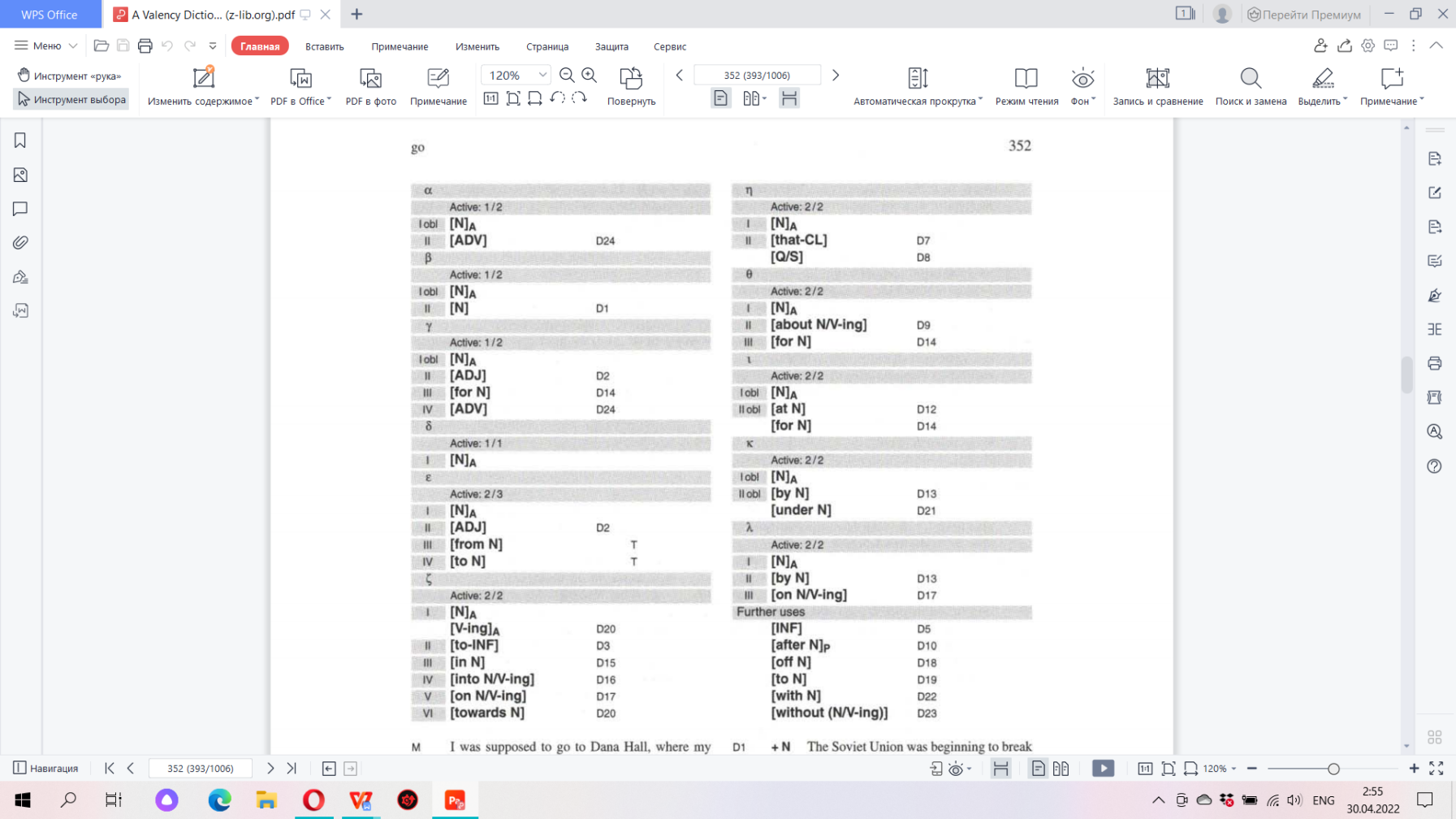1.
The
object of Lexicology. General, special, historical, descriptive;
sociolinguistics.
Lexicology
– is the branch of linguistic dealing with vocabulary of the
language and the properties of words or main units of the language.
General
lexicology
studies linguistic phenomena and properties common to all languages,
general studying of words and voc. irrespective of specific features
of any part of language.
Special
linguistic –
devotes its attention to the description of the characteristic
peculiarities in the given language. Historical
linguistic
— studies the evolution of any vocabulary as well as single elements,
discusses the origin of words. Descriptive
linguistic
– deals with the vocabulary of a given language at a given stage of
its development, studies the function of words and their specific
features as characteristic inherent in the system. Socio-
linguistics
– a branch of ling. dealing with casual relations between the way
the language develops and the fact of social life. Every new
phenomenon in human society finds reflection in a vocabulary.
Phonetics.
On acoustic level words consist of phonemes and these phonemes
participate in the significations. They have no meaning but their
function is to build up morphemes, which served to distinguish
between meanings.
Stylistics
studies many problems treated in lexicology: these are the problem of
meaning, synonyms, differentiation of vocabulary according to the
sphere of communication. Grammar.
It attends to establish rules for the correct use of the language in
society. Every word alongside with the lex. meaning has some
grammatical meaning.
3. The Structural Aspects of the word.
The word
is
a unit of speech, which serves the purposes of human communication
materially representing the group of sounds possessing a meaning
susceptible to grammatical employment and characterized by formal and
semantic unity. So it can be defined as: a unity of communication; it
can be perceived as the total of sounds; structurally it possess some
functions.
There is
external
(morphological) and internal
(the meaning — semantic) structure of the word.
4. A brief Account of the main characteristics of a word.
-
The
distinguishing between external
(morphological) and internal
(the meaning — semantic) structure of the word. -
Unity.
The
word has external and internal unity. Formal
unity is sometimes inaccurately interpreted as indivisibility
of
the word. But we can divide it into morphemes but their components
are linked together. We can compare words to groups whose components
have a certain structural freedom. (E.g.: bluebell
(type
of flower)
– blue bell (colour
and object))
If it is word we can change the whole of it, phrase – all
components. -
Susceptibility
to
grammatical employment. Words can be used in different grammatical
forms and thus they realize the interrelations.
5. The main problems of Lexicology
Word
building. It’s
connected with word structure
and
process of coining new words.
Semantics. It’s
the study of meaning.
2
approach of studying this problem: syntagmatic
(the
word is studied in its liner relationships with neighboring
words.), paradigmatics
(word
is studied in its relationships with other words in voc. system;
with the synonymy, antonymy and different stylistic
characteristics.). E.g.: girl
– bird, chick, colee, damsel .
Phraseology.
The
branch of lex. specializing in word groups which are characterized by
stability of structure and transferred meaning. E.g.: To
be at a loss.
The
study of voc. as a system.
2
approaches: synchronically
(at
a given stage of development), diachronically
(in
the contents
of
the process
through
it grew, developed, acquired in modern form.).
-
Formal and Informal style.
The style
can be divided into 2: formal and informal, depending on the
situations. The situations can be formal
(professional
communication, reception, lecture, talk to a teacher or manager),
informal
(talk to friends, relatives, an intimate letter).
Informal
vocabulary
is used in two-way everyday conversation, when you are at home, or
feeling like home. The choice of words in each particular situation
is determined not only by formal or informal situation but also by
the speaker education, cultural background, age group, his occupation
and regional characteristics. That’s why the inf. Words are
subdivided into 3 subgroups: colloquialisms, slang, and dialect
words.
Formal
words.
They are divided into 3 groups: learned words, professional words,
obsolete and archaic words.
-
Colloquial
speech. The main features and characteristics.
-
They
are
the least exclusive (90% of people use them every day). Their sphere
of communication is wide. -
They are
subdivided: literary
coll.
(used by educated people, printer pages: pall,
chum – friend; bite, snake – meal),
familiar
(used by the young and semi-educated, it is more emotional and free:
ta-ta
– good bye; doc – doctor),
low
(“speech
of persons who may only be described as uncultivated” –
G.P.Kropp. These are words of illiterate language.).
-
Definition
of slang. Main features.
It
is informal non-standard voc., usually intelligible only to people
from a particular region or social group such as doctors, sailors.
The
main features:
-
It
is a lang. of coll. style considered as below the level of standard
educational speech and consisting either of new words or of current
wards employed in some special sense. -
Slang
is metaphor. -
Each
slang metaphor is ruted in a joke with cinical colouring. -
The
circle of users is narrower than that of coll. words It’s mainly
used by the young and uneducated. -
Slang
is subject to rapid change. So it is short-lived.
-
Dialect
and variant. The main features of dialect words.
Dialect
– is a variety of language, which prevails in a districts with
local peculiarities of voc., pronunciation, phrase.
Variant –
is
original variety possessing a literary form.
In
G.B there are 2 variants: Scottish, Irish. There are 5 dialects:
Northern, Midland, Eastern, Western and Southern. Every group has 4
or 5dialects.
Cockney
– Southern dialect (London). It exists in 2 levels: as spoken by
educated and uneducated people. Features of Cockney dialect
-
Interchange
between [W] and [V]: [vel]
– [wel] – well -
The
voiceless and voiced dental spirants: [O] – [f] fing
– thing; [
] – [v] faver
– father. -
Interchange
of the aspirated and non-aspirated initial sounds: heart
– ‘eart. -
Substitution
of diphthongs: day-
[dai], way – [wai].
Features:
1.
Dialect
peculiarities especially those of voc are constantly being
incorporated into coll. speech. From these levels they can come into
common stock. E.g.: car,
tram ,trolley – used
to be dialect words.
-
Using
dialect words is the bright, expressive means.
-
Learned
words.
-
They
are associated with printed pages. -
Sphere
of usage; they are used by educated and highly educated people. -
They
are subdivided into:
-
Scientific
prose – identified
by their dry flavour: comprise,
compile, homogeneous. -
Officialese
–
words
of the official, bueurocratic language. They should be avoided in
speech: to
assist – to help, to proceed – to go, approximately – about. -
Literary
words –
described
as refined, they are used in descriptive passages of fiction. They
are represented by the words of Roman languages and though fully
adopted to English phonetic system still sound foreign: solitude,
sentiment, fascination, cordial, allusive. -
Modes
of poetic diction –
they
are lofty, high-flown, archaic, coloured, used only in poetry:
alas,
constancy – верность,
duth – do.
-
Archaisms,
obsolete words and historisms, their general characteristics.
Obsolete
words
– are no longer in use, especially out of use for at least a
century. Archaic
words
– are current in earlier times, but rare in present usage.
Historisms
– are
words denoting objects and phenomena, which are thing of the past and
no longer exist.
Features:
-
They
stand close to the learned words (modes of poetic dictions) -
Archaisms
are associated with printed pages. -
They
are moribund, are out of circulation, rejected by living lang. and
are not used in conversational situations. -
They
are met in historical novels and poetry. They are used to create a
particular period of time. -
Sometimes
archaic words may undergo a sudden reveal: kin
used
to be archaic word.
E.g.: thou
– you, thy – your, nay –no, aye- yes.
-
Professional
terminology. Features of term. Problems in terminology.
Terminology
is
the set of technical words used in a particular subject such as
physics, art, lang. study. Terminological system embraces many of
specialized fields such as scientific, professional or treat areas.
Every field of modern activity has its specialized vocabulary.
Term is
a word or word group, which is specially used by a particular brunch
of science, technology, trade, arts to convey a concept, which is
specific to this particular activity.
Features
of term:
-
Terms
are deprived of emotional colouring. -
They
are not for general use, they are used by narrow circle of people. -
Sometimes
they may obtain more generalized meaning (electricity) -
Terms
can be polysemantic and can have synonyms. -
Terms can
be simple containing word or complex: electromotive
force. -
The origin
of number of terms is Latin: index,
metaphor, Present Indefinite. -
They
are built up according to the rules of word building. -
Terms
are borrowed from other languages.
Problems
of terminology.
-
Whether
term loses its terminological status when it comes into common usage
or not. Most scholars think that it’s quite natural that a great
number of terms pass into general usage. E.g.: measles,
electricity. -
Synonymy
and polisemy in terminology. Some scholars consider the term to have
no synonyms and to be monosemantic. It sounds reasonable but in
reality terms do possess synonyms and many terms are polysemantic.
E.g.: to
dress-перевязывать
рану
(medical), готовить
землю
к
посеву
(agricultural), выстраивать
в
шеренгу
(military).
-
Basic
vocabulary words, their main features.
Basic
voc. – a
central group, a basic core of the language. It doesn’t include all
words but only that part which comprises lexical foundation of the
language.
Main
features:
-
B.V is
the central group of the vocabulary, its living core. They show a
great stability, undergo changes but slowly. They denote objects and
phenomena of everyday importance. -
Stylistically
these words are neutral, that is they are used in all kinds of
situations both formal and informal. They are used by everybody
every day. -
These
are words without which no human communication would be possible. -
Basic
vocabulary words have no connotations. Their meaning is board and
directly conveys the concept without supplying any additional
information.
- Размер: 211 Кб
- Количество слайдов: 39
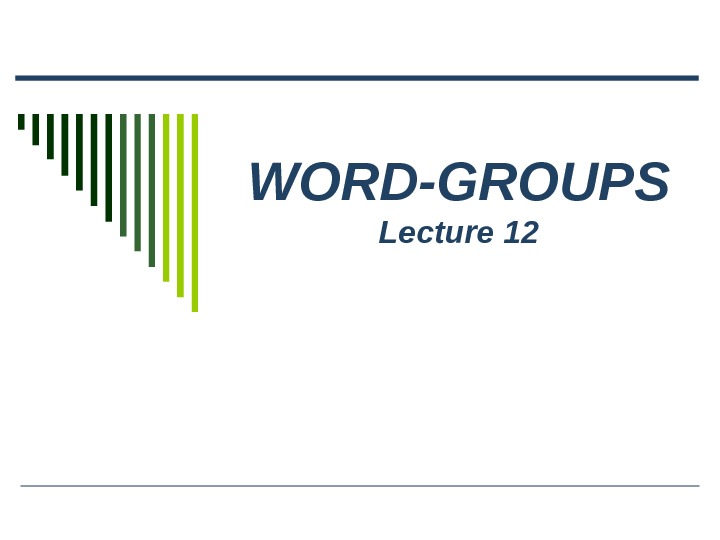
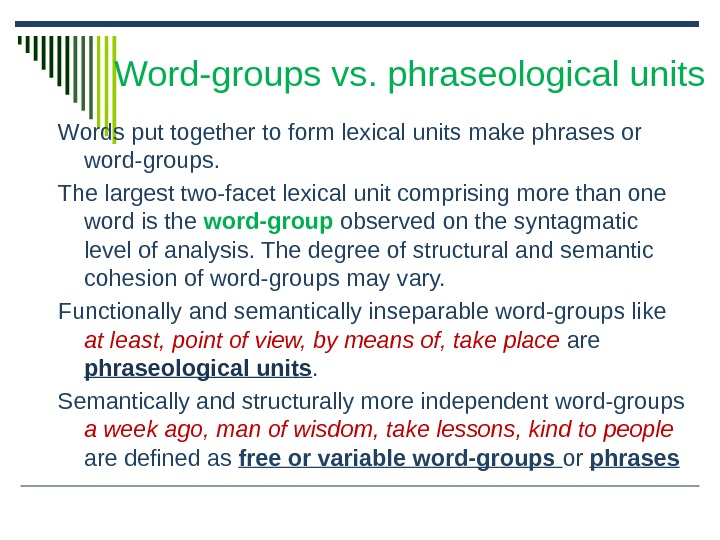
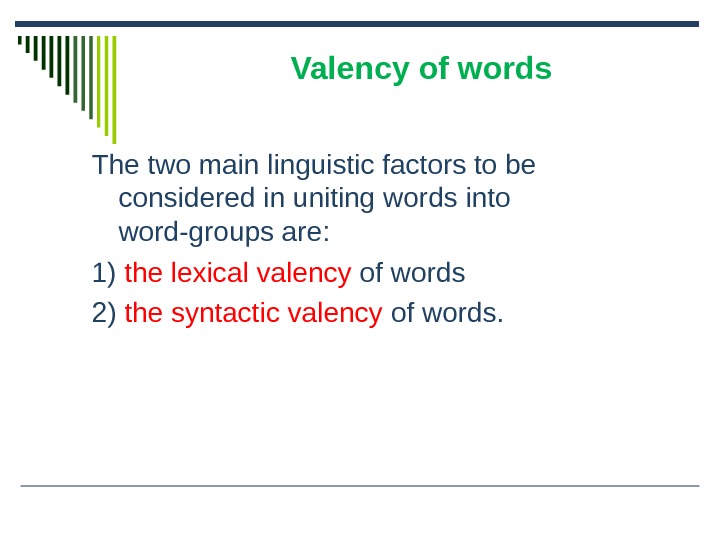
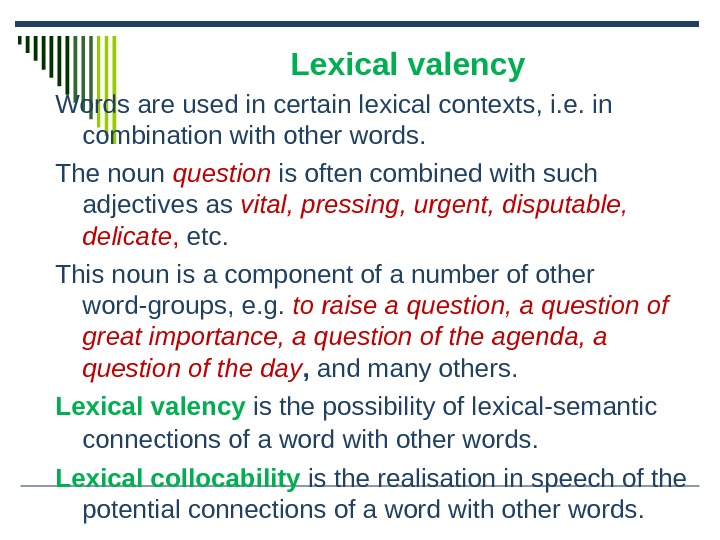
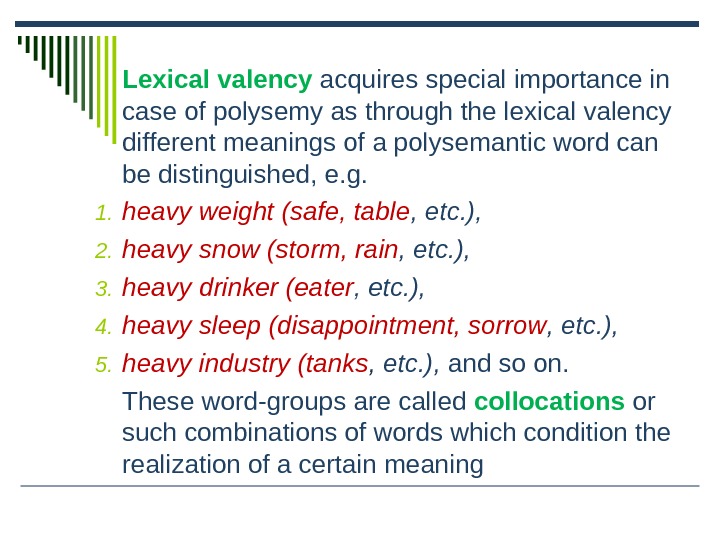
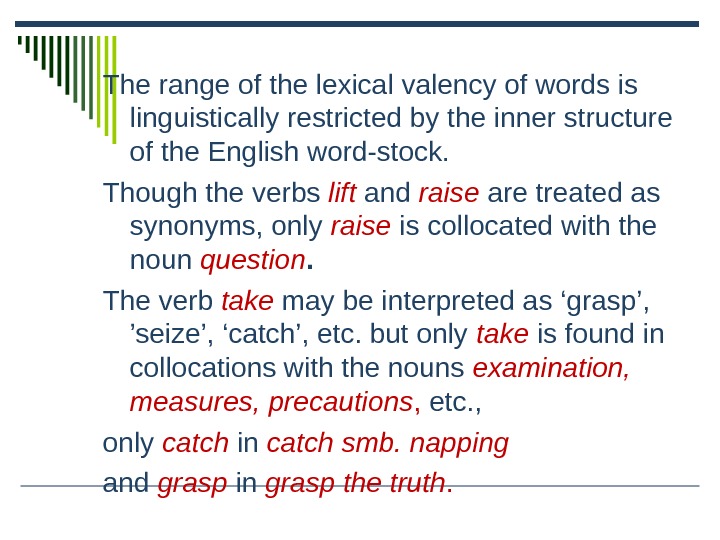
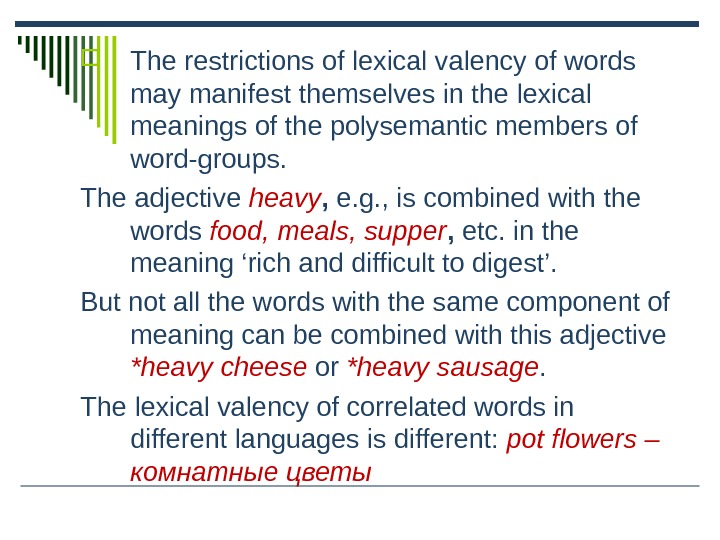
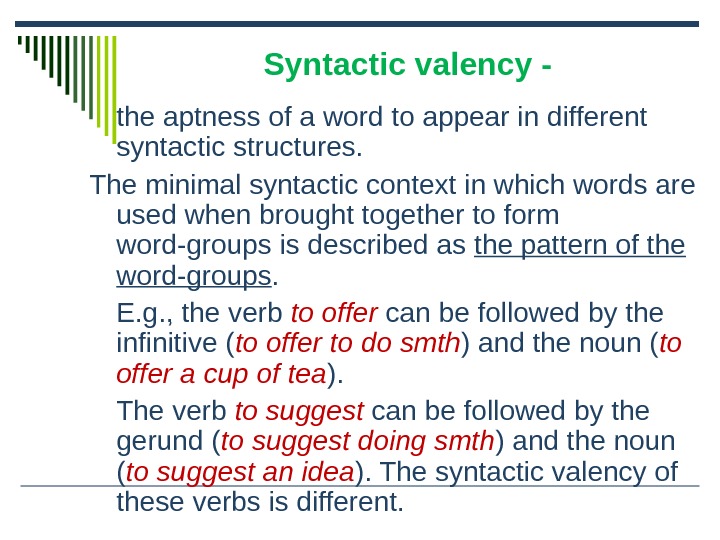
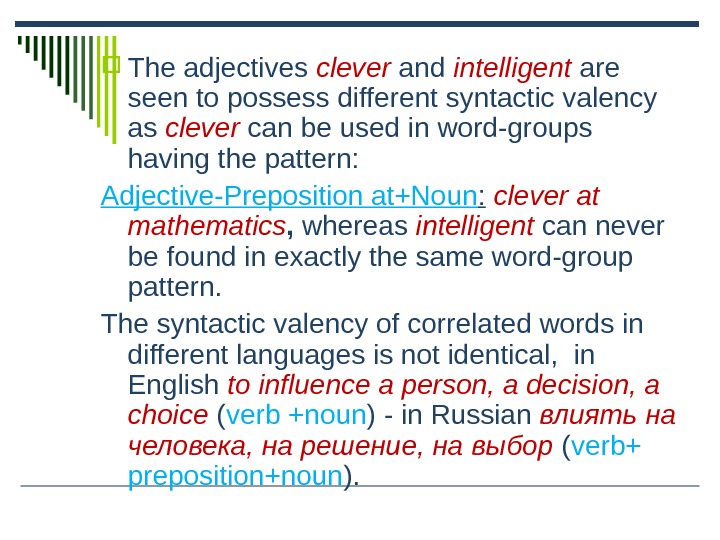
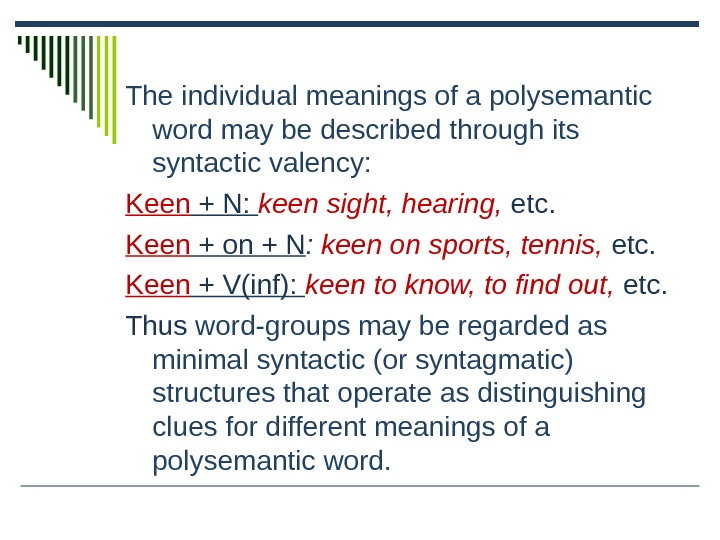
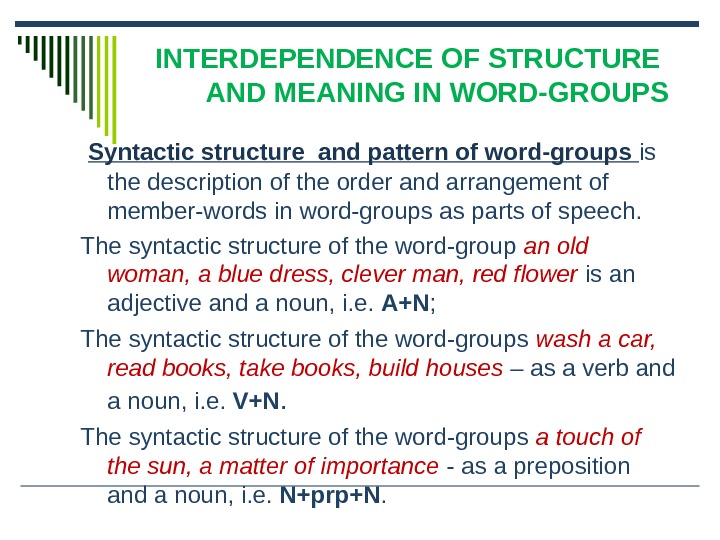

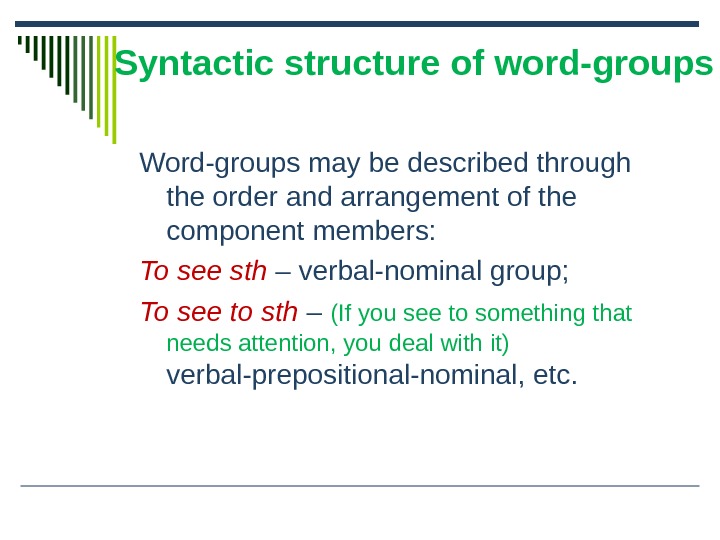

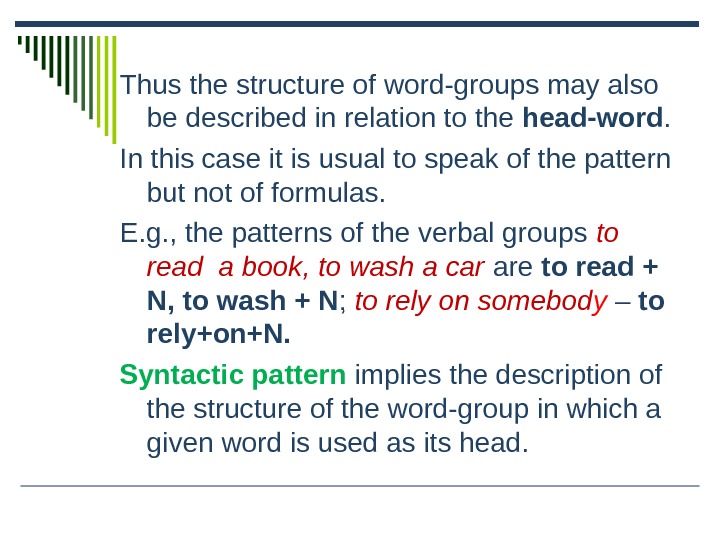

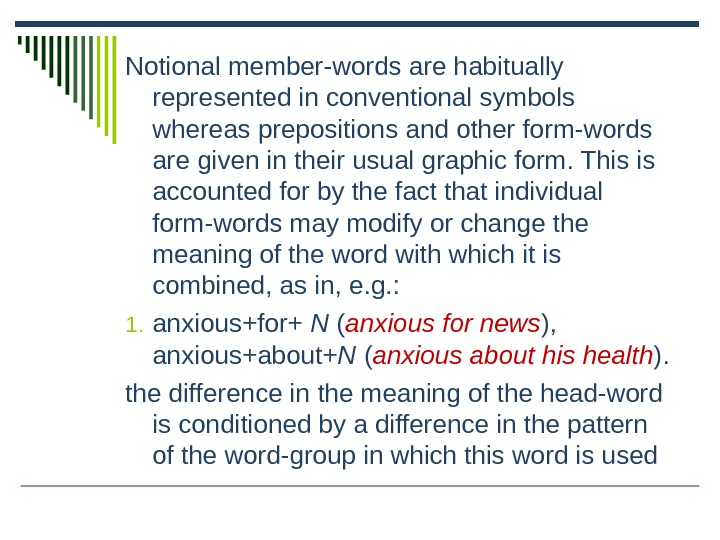
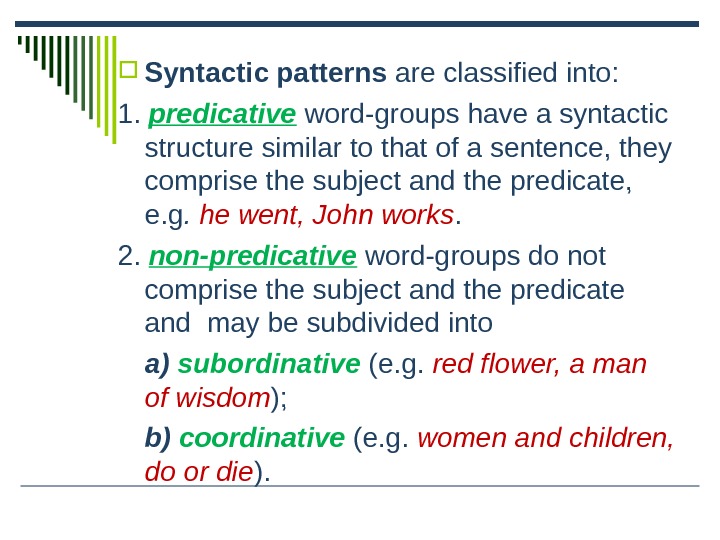

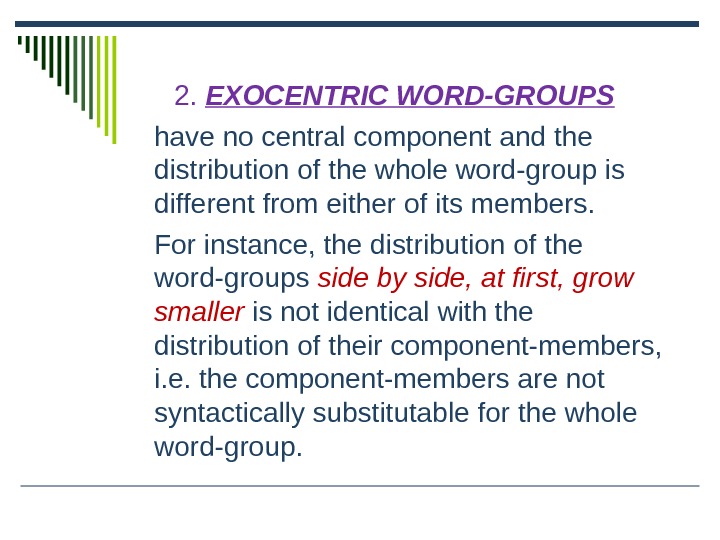



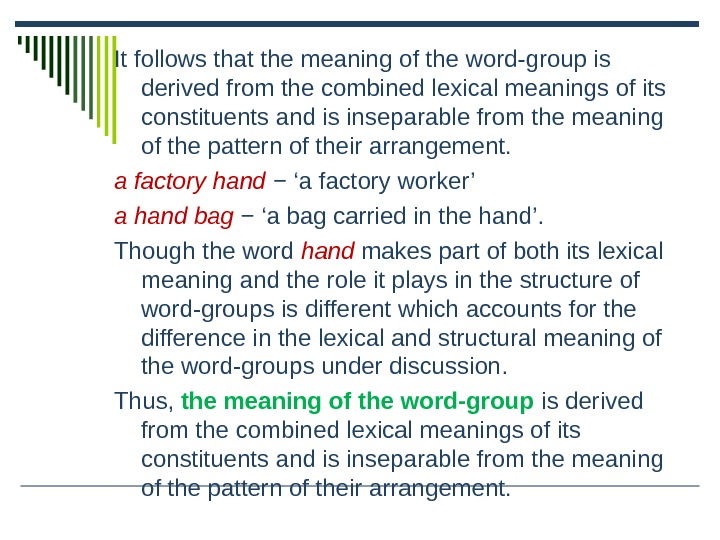
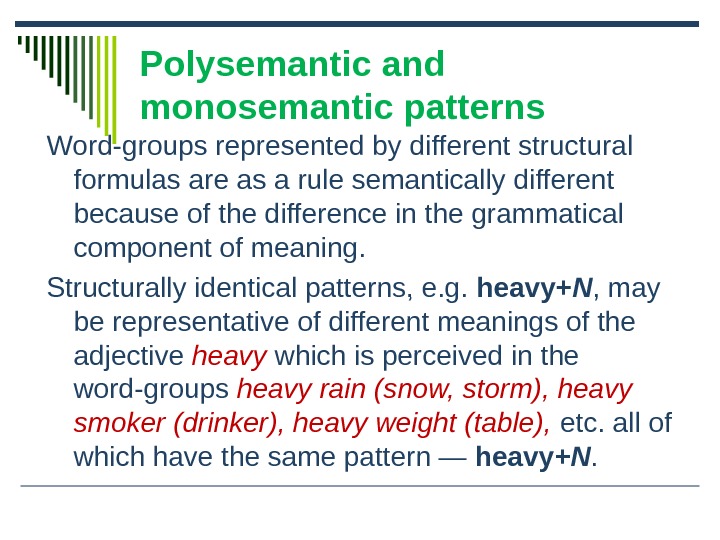
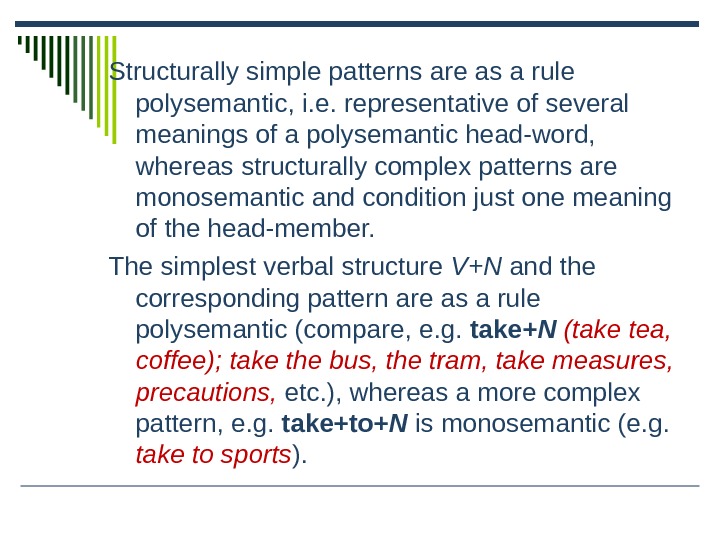

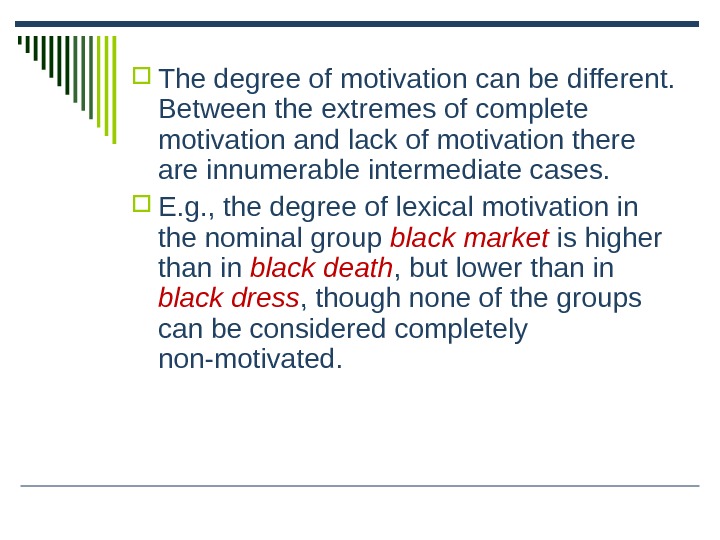

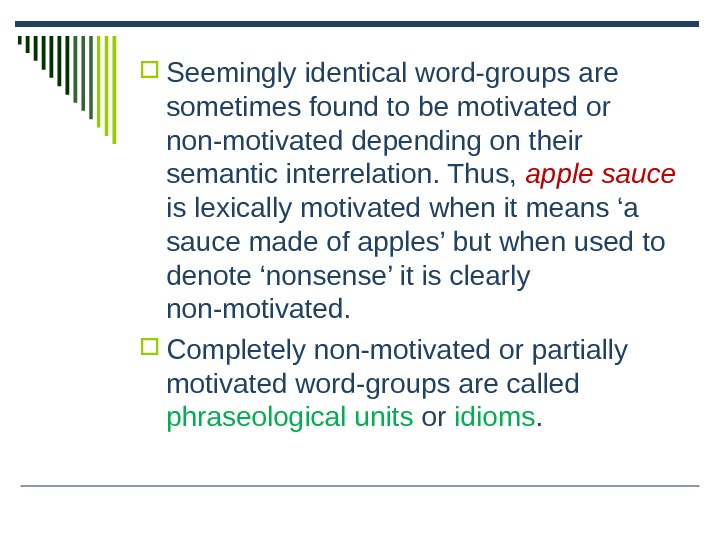
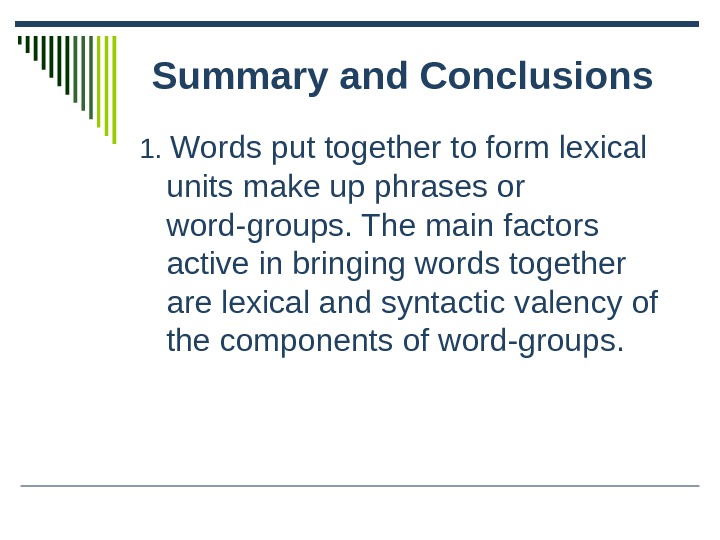
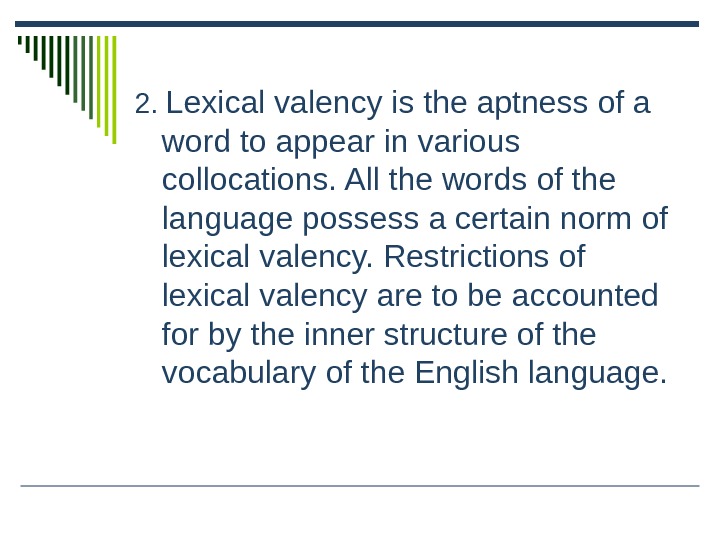
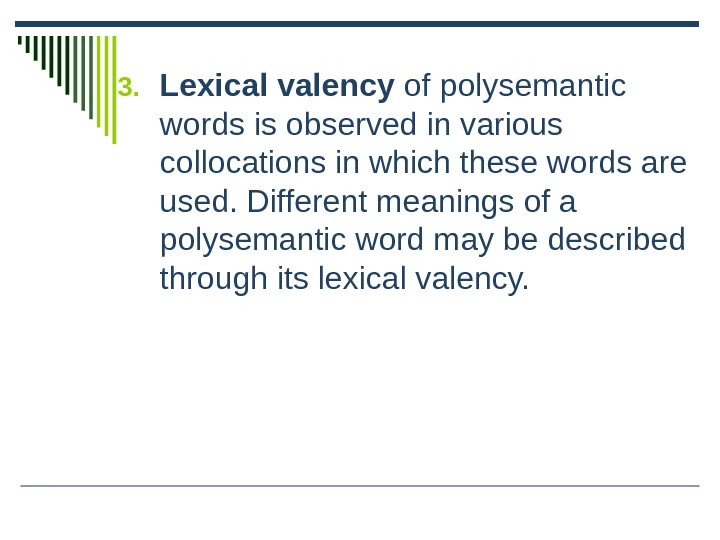
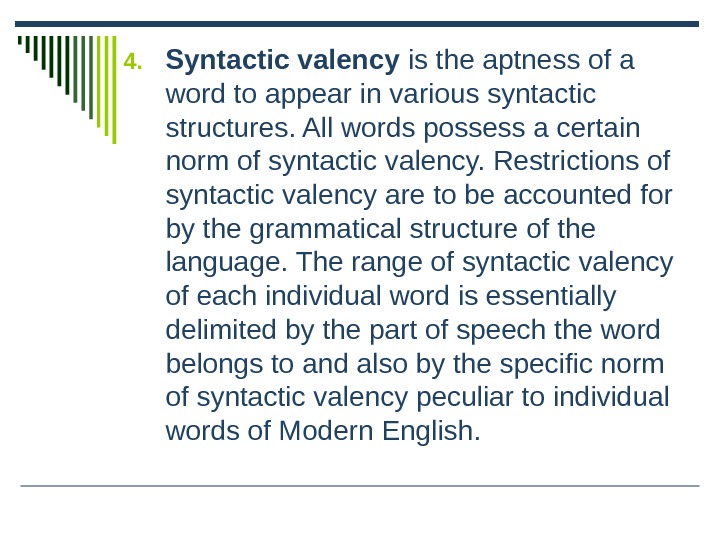

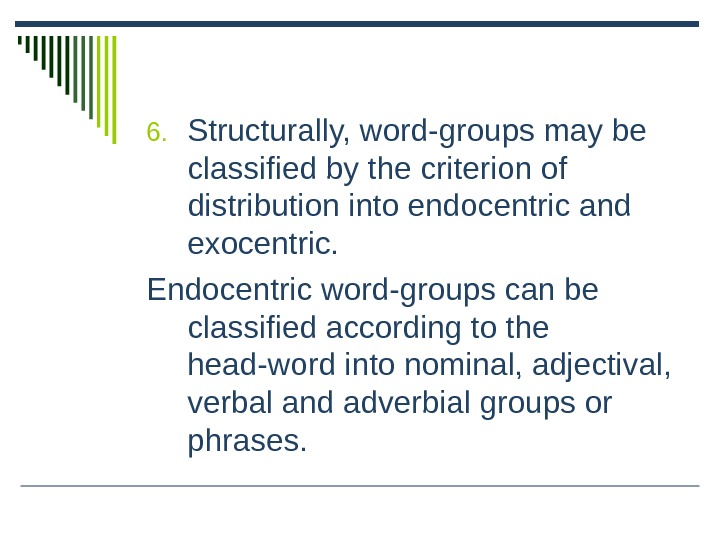
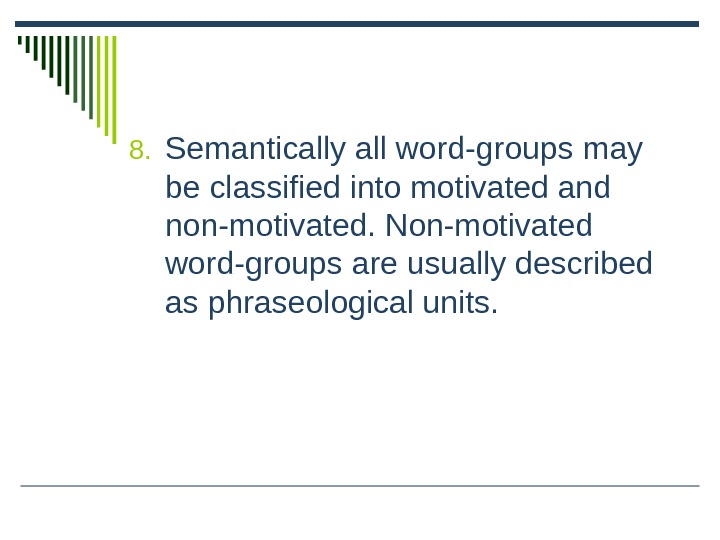
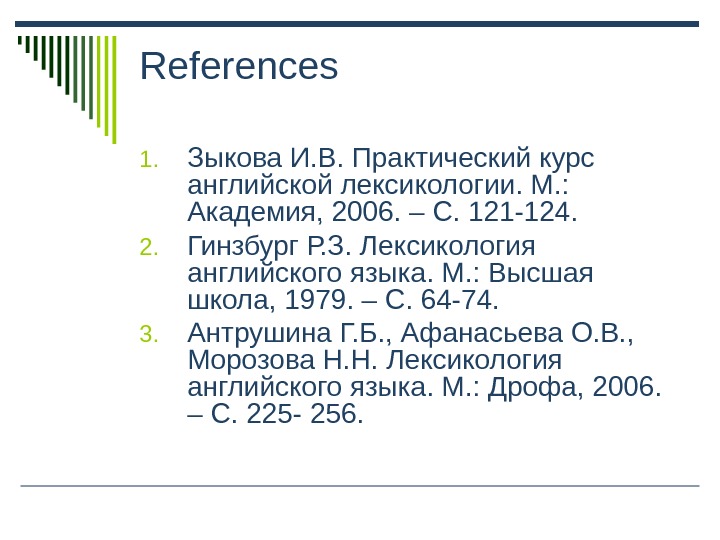

Подборка по базе: Документ Microsoft Word (3).docx, Документ Microsoft Word (3).docx, Документ Microsoft Word (2).docx, Документ Microsoft Word.docx, Документ Microsoft Word (2).docx, Документ Microsoft Word (3).docx, Документ Microsoft Word (2).docx, Microsoft Word Document.docx, Документ Microsoft Word.docx, Документ Microsoft Word.docx
Семинар 6 Combinability. Word Groups
KEY TERMS
Syntagmatics — linear (simultaneous) relationship of words in speech as distinct from associative (non-simultaneous) relationship of words in language (paradigmatics). Syntagmatic relations specify the combination of elements into complex forms and sentences.
Distribution — The set of elements with which an item can cooccur
Combinability — the ability of linguistic elements to combine in speech.
Valency — the potential ability of words to occur with other words
Context — the semantically complete passage of written speech sufficient to establish the meaning of a given word (phrase).
Clichе´ — an overused expression that is considered trite, boring
Word combination — a combination of two or more notional words serving to express one concept. It is produced, not reproduced in speech.
Collocation — such a combination of words which conditions the realization of a certain meaning
TOPICS FOR DISCUSSION AND EXERCISES
1. Syntagmatic relations and the concept of combinability of words. Define combinability.
Syntagmatic relation defines the relationship between words that co-occur in the same sentence. It focuses on two main parts: how the position and the word order affect the meaning of a sentence.
The syntagmatic relation explains:
• The word position and order.
• The relationship between words gives a particular meaning to the sentence.
The syntagmatic relation can also explain why specific words are often paired together (collocations)
Syntagmatic relations are linear relations between words
The adjective yellow:
1. color: a yellow dress;
2. envious, suspicious: a yellow look;
3. corrupt: the yellow press
TYPES OF SEMANTIC RELATIONS
Because syntagmatic relations have to do with the relationship between words, the syntagms can result in collocations and idioms.
Collocations
Collocations are word combinations that frequently occur together.
Some examples of collocations:
- Verb + noun: do homework, take a risk, catch a cold.
- Noun + noun: office hours, interest group, kitchen cabinet.
- Adjective + adverb: good enough, close together, crystal clear.
- Verb + preposition: protect from, angry at, advantage of.
- Adverb + verb: strongly suggest, deeply sorry, highly successful.
- Adjective + noun: handsome man, quick shower, fast food.
Idioms
Idioms are expressions that have a meaning other than their literal one.
Idioms are distinct from collocations:
- The word combination is not interchangeable (fixed expressions).
- The meaning of each component is not equal to the meaning of the idiom
It is difficult to find the meaning of an idiom based on the definition of the words alone. For example, red herring. If you define the idiom word by word, it means ‘red fish’, not ‘something that misleads’, which is the real meaning.
Because of this, idioms can’t be translated to or from another language because the word definition isn’t equivalent to the idiom interpretation.
Some examples of popular idioms:
- Break a leg.
- Miss the boat.
- Call it a day.
- It’s raining cats and dogs.
- Kill two birds with one stone.
Combinability (occurrence-range) — the ability of linguistic elements to combine in speech.
The combinability of words is as a rule determined by their meanings, not their forms. Therefore not every sequence of words may be regarded as a combination of words.
In the sentence Frankly, father, I have been a fool neither frankly, father nor father, I … are combinations of words since their meanings are detached and do not unite them, which is marked orally by intonation and often graphically by punctuation marks.
On the other hand, some words may be inserted between the components of a word-combination without breaking it.
Compare,
a) read books
b) read many books
c) read very many books.
In case (a) the combination read books is uninterrupted.In cases (b) and (c) it is interrupted, or discontinuous(read… books).
The combinability of words depends on their lexical, grammatical and lexico-grammatical meanings. It is owing to the lexical meanings of the corresponding lexemes that the word wise can be combined with the words man, act, saying and is hardly combinable with the words milk, area, outline.
The lexico-grammatical meanings of -er in singer (a noun) and -ly in beautifully (an adverb) do not go together and prevent these words from forming a combination, whereas beautiful singer and sing beautifully are regular word-combinations.
The combination * students sings is impossible owing to the grammatical meanings of the corresponding grammemes.
Thus one may speak of lexical, grammatical and lexico-grammatical combinability, or the combinability of lexemes, grammemes and parts of speech.
The mechanism of combinability is very complicated. One has to take into consideration not only the combinability of homogeneous units, e. g. the words of one lexeme with those of another lexeme. A lexeme is often not combinable with a whole class of lexemes or with certain grammemes.
For instance, the lexeme few, fewer, fewest is not combinable with a class of nouns called uncountables, such as milk, information, hatred, etc., or with members of ‘singular’ grammemes (i. e. grammemes containing the meaning of ‘singularity’, such as book, table, man, boy, etc.).
The ‘possessive case’ grammemes are rarely combined with verbs, barring the gerund. Some words are regularly combined with sentences, others are not.
It is convenient to distinguish right-hand and left-hand connections. In the combination my hand (when written down) the word my has a right-hand connection with the word hand and the latter has a left-hand connection with the word my.
With analytical forms inside and outside connections are also possible. In the combination has often written the verb has an inside connection with the adverb and the latter has an outside connection with the verb.
It will also be expedient to distinguish unilateral, bilateral and multilateral connections. By way of illustration we may say that the articles in English have unilateral right-hand connections with nouns: a book, the child. Such linking words as prepositions, conjunctions, link-verbs, and modal verbs are characterized by bilateral connections: love of life, John and Mary, this is John, he must come. Most verbs may have zero
(Come!), unilateral (birds fly), bilateral (I saw him) and multilateral (Yesterday I saw him there) connections. In other words, the combinability of verbs is variable.
One should also distinguish direct and indirect connections. In the combination Look at John the connection between look and at, between at and John are direct, whereas the connection between look and John is indirect, through the preposition at.
2. Lexical and grammatical valency. Valency and collocability. Relationships between valency and collocability. Distribution.
The appearance of words in a certain syntagmatic succession with particular logical, semantic, morphological and syntactic relations is called collocability or valency.
Valency is viewed as an aptness or potential of a word to have relations with other words in language. Valency can be grammatical and lexical.
Collocability is an actual use of words in particular word-groups in communication.
The range of the Lexical valency of words is linguistically restricted by the inner structure of the English word-stock. Though the verbs ‘lift’ and ‘raise’ are synonyms, only ‘to raise’ is collocated with the noun ‘question’.
The lexical valency of correlated words in different languages is different, cf. English ‘pot plants’ vs. Russian ‘комнатные цветы’.
The interrelation of lexical valency and polysemy:
• the restrictions of lexical valency of words may manifest themselves in the lexical meanings of the polysemantic members of word-groups, e.g. heavy, adj. in the meaning ‘rich and difficult to digest’ is combined with the words food, meals, supper, etc., but one cannot say *heavy cheese or *heavy sausage;
• different meanings of a word may be described through its lexical valency, e.g. the different meanings of heavy, adj. may be described through the word-groups heavy weight / book / table; heavy snow / storm / rain; heavy drinker / eater; heavy sleep / disappointment / sorrow; heavy industry / tanks, and so on.
From this point of view word-groups may be regarded as the characteristic minimal lexical sets that operate as distinguishing clues for each of the multiple meanings of the word.
Grammatical valency is the aptness of a word to appear in specific grammatical (or rather syntactic) structures. Its range is delimited by the part of speech the word belongs to. This is not to imply that grammatical valency of words belonging to the same part of speech is necessarily identical, e.g.:
• the verbs suggest and propose can be followed by a noun (to propose or suggest a plan / a resolution); however, it is only propose that can be followed by the infinitive of a verb (to propose to do smth.);
• the adjectives clever and intelligent are seen to possess different grammatical valency as clever can be used in word-groups having the pattern: Adj. + Prep. at +Noun(clever at mathematics), whereas intelligent can never be found in exactly the same word-group pattern.
• The individual meanings of a polysemantic word may be described through its grammatical valency, e.g. keen + Nas in keen sight ‘sharp’; keen + on + Nas in keen on sports ‘fond of’; keen + V(inf)as in keen to know ‘eager’.
Lexical context determines lexically bound meaning; collocations with the polysemantic words are of primary importance, e.g. a dramatic change / increase / fall / improvement; dramatic events / scenery; dramatic society; a dramatic gesture.
In grammatical context the grammatical (syntactic) structure of the context serves to determine the meanings of a polysemantic word, e.g. 1) She will make a good teacher. 2) She will make some tea. 3) She will make him obey.
Distribution is understood as the whole complex of contexts in which the given lexical unit(word) can be used. Есть даже словари, по которым можно найти валентные слова для нужного нам слова — так и называются дистрибьюшн дикшенери
3. What is a word combination? Types of word combinations. Classifications of word-groups.
Word combination — a combination of two or more notional words serving to express one concept. It is produced, not reproduced in speech.
Types of word combinations:
- Semantically:
- free word groups (collocations) — a year ago, a girl of beauty, take lessons;
- set expressions (at last, point of view, take part).
- Morphologically (L.S. Barkhudarov):
- noun word combinations, e.g.: nice apples (BBC London Course);
- verb word combinations, e.g.: saw him (E. Blyton);
- adjective word combinations, e.g.: perfectly delightful (O. Wilde);
- adverb word combinations, e.g.: perfectly well (O, Wilde);
- pronoun word combinations, e.g.: something nice (BBC London Course).
- According to the number of the components:
- simple — the head and an adjunct, e.g.: told me (A. Ayckbourn)
- Complex, e.g.: terribly cold weather (O. Jespersen), where the adjunct cold is expanded by means of terribly.
Classifications of word-groups:
- through the order and arrangement of the components:
• a verbal — nominal group (to sew a dress);
• a verbal — prepositional — nominal group (look at something);
- by the criterion of distribution, which is the sum of contexts of the language unit usage:
• endocentric, i.e. having one central member functionally equivalent to the whole word-group (blue sky);
• exocentric, i.e. having no central member (become older, side by side);
- according to the headword:
• nominal (beautiful garden);
• verbal (to fly high);
• adjectival (lucky from birth);
- according to the syntactic pattern:
• predicative (Russian linguists do not consider them to be word-groups);
• non-predicative — according to the type of syntactic relations between the components:
(a) subordinative (modern technology);
(b) coordinative (husband and wife).
4. What is “a free word combination”? To what extent is what we call a free word combination actually free? What are the restrictions imposed on it?
A free word combination is a combination in which any element can be substituted by another.
The general meaning of an ordinary free word combination is derived from the conjoined meanings of its elements
Ex. To come to one’s sense –to change one’s mind;
To fall into a rage – to get angry.
Free word-combinations are word-groups that have a greater semantic and structural independence and freely composed by the speaker in his speech according to his purpose.
A free word combination or a free phrase permits substitution of any of its elements without any semantic change in the other components.
5. Clichе´s (traditional word combinations).
A cliché is an expression that is trite, worn-out, and overused. As a result, clichés have lost their original vitality, freshness, and significance in expressing meaning. A cliché is a phrase or idea that has become a “universal” device to describe abstract concepts such as time (Better Late Than Never), anger (madder than a wet hen), love (love is blind), and even hope (Tomorrow is Another Day). However, such expressions are too commonplace and unoriginal to leave any significant impression.
Of course, any expression that has become a cliché was original and innovative at one time. However, overuse of such an expression results in a loss of novelty, significance, and even original meaning. For example, the proverbial phrase “when it rains it pours” indicates the idea that difficult or inconvenient circumstances closely follow each other or take place all at the same time. This phrase originally referred to a weather pattern in which a dry spell would be followed by heavy, prolonged rain. However, the original meaning is distanced from the overuse of the phrase, making it a cliché.
Some common examples of cliché in everyday speech:
- My dog is dumb as a doorknob. (тупой как пробка)
- The laundry came out as fresh as a daisy.
- If you hide the toy it will be out of sight, out of mind. (с глаз долой, из сердца вон)
Examples of Movie Lines that Have Become Cliché:
- Luke, I am your father. (Star Wars: The Empire Strikes Back)
- i am Groot. (Guardians of the Galaxy)
- I’ll be back. (The Terminator)
- Houston, we have a problem. (Apollo 13)
Some famous examples of cliché in creative writing:
- It was a dark and stormy night
- Once upon a time
- There I was
- All’s well that ends well
- They lived happily ever after
6. The sociolinguistic aspect of word combinations.
Lexical valency is the possibility of lexicosemantic connections of a word with other word
Some researchers suggested that the functioning of a word in speech is determined by the environment in which it occurs, by its grammatical peculiarities (part of speech it belongs to, categories, functions in the sentence, etc.), and by the type and character of meaning included into the semantic structure of a word.
Words are used in certain lexical contexts, i.e. in combinations with other words. The words that surround a particular word in a sentence or paragraph are called the verbal context of that word.
7. Norms of lexical valency and collocability in different languages.
The aptness of a word to appear in various combinations is described as its lexical valency or collocability. The lexical valency of correlated words in different languages is not identical. This is only natural since every language has its syntagmatic norms and patterns of lexical valency. Words, habitually collocated, tend to constitute a cliché, e.g. bad mistake, high hopes, heavy sea (rain, snow), etc. The translator is obliged to seek similar cliches, traditional collocations in the target-language: грубая ошибка, большие надежды, бурное море, сильный дождь /снег/.
The key word in such collocations is usually preserved but the collocated one is rendered by a word of a somewhat different referential meaning in accordance with the valency norms of the target-language:
- trains run — поезда ходят;
- a fly stands on the ceiling — на потолке сидит муха;
- It was the worst earthquake on the African continent (D.W.) — Это было самое сильное землетрясение в Африке.
- Labour Party pretest followed sharply on the Tory deal with Spain (M.S.1973) — За сообщением о сделке консервативного правительства с Испанией немедленно последовал протест лейбористской партии.
Different collocability often calls for lexical and grammatical transformations in translation though each component of the collocation may have its equivalent in Russian, e.g. the collocation «the most controversial Prime Minister» cannot be translated as «самый противоречивый премьер-министр».
«Britain will tomorrow be welcoming on an official visit one of the most controversial and youngest Prime Ministers in Europe» (The Times, 1970). «Завтра в Англию прибывает с официальным визитом один из самых молодых премьер-министров Европы, который вызывает самые противоречивые мнения».
«Sweden’s neutral faith ought not to be in doubt» (Ib.) «Верность Швеции нейтралитету не подлежит сомнению».
The collocation «documentary bombshell» is rather uncommon and individual, but evidently it does not violate English collocational patterns, while the corresponding Russian collocation — документальная бомба — impossible. Therefore its translation requires a number of transformations:
«A teacher who leaves a documentary bombshell lying around by negligence is as culpable as the top civil servant who leaves his classified secrets in a taxi» (The Daily Mirror, 1950) «Преподаватель, по небрежности оставивший на столе бумаги, которые могут вызвать большой скандал, не менее виновен, чем ответственный государственный служащий, забывший секретные документы в такси».
8. Using the data of various dictionaries compare the grammatical valency of the words worth and worthy; ensure, insure, assure; observance and observation; go and walk; influence and влияние; hold and держать.
| Worth & Worthy | |
| Worth is used to say that something has a value:
• Something that is worth a certain amount of money has that value; • Something that is worth doing or worth an effort, a visit, etc. is so attractive or rewarding that the effort etc. should be made. Valency:
|
Worthy:
• If someone or something is worthv of something, they deserve it because they have the qualities required; • If you say that a person is worthy of another person you are saying that you approve of them as a partner for that person. Valency:
|
| Ensure, insure, assure | ||
| Ensure means ‘make certain that something happens’.
Valency:
|
Insure — make sure
Valency:
|
Assure:
• to tell someone confidently that something is true, especially so that they do not worry; • to cause something to be certain. Valency:
|
| Observance & Observation | |
| Observance:
• the act of obeying a law or following a religious custom: religious observances such as fasting • a ceremony or action to celebrate a holiday or a religious or other important event: [ C ] Memorial Day observances [ U ] Financial markets will be closed Monday in observance of Labor Day. |
Observation:
• the act of observing something or someone; • the fact that you notice or see something; • a remark about something that you have noticed. Valency:
|
| Go & Walk | |
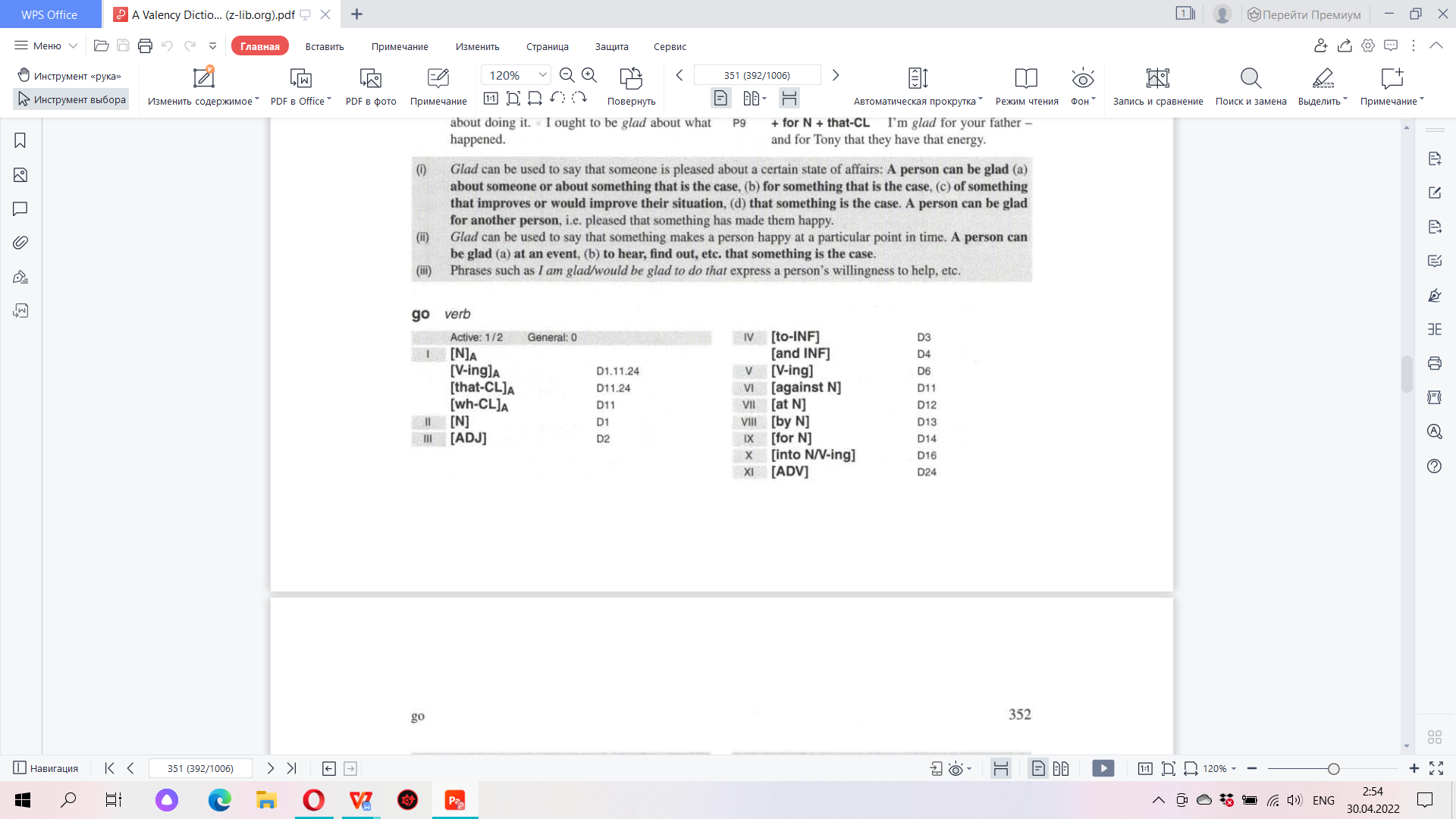
|
Walk can mean ‘move along on foot’:
• A person can walk an animal, i.e. exercise them by walking. • A person can walk another person somewhere , i.e. take them there, • A person can walk a particular distance or walk the streets. Valency:
|
| Influence & Влияние | |
| Influence:
• A person can have influence (a) over another person or a group, i.e. be able to directly guide the way they behave, (b) with a person, i.e. be able to influence them because they know them well. • Someone or something can have or be an influence on or upon something or someone, i.e. be able to affect their character or behaviour in some way Valency:
|
Влияние — Действие, оказываемое кем-, чем-либо на кого-, что-либо.
Сочетаемость:
|
| Hold & Держать | |
| Hold:
• to take and keep something in your hand or arms; • to support something; • to contain or be able to contain something; • to keep someone in a place so that they cannot leave. Valency:
|
Держать — взять в руки/рот/зубы и т.д. и не давать выпасть
Сочетаемость:
|
- Contrastive Analysis. Give words of the same root in Russian; compare their valency:
| Chance | Шанс |
|
|
| Situation | Ситуация |
|
|
| Partner | Партнёр |
|
|
| Surprise | Сюрприз |
|
|
| Risk | Риск |
|
|
| Instruction | Инструкция |
|
|
| Satisfaction | Сатисфакция |
|
|
| Business | Бизнес |
|
|
| Manager | Менеджер |
|
|
| Challenge | Челлендж |
|
|
10. From the lexemes in brackets choose the correct one to go with each of the synonyms given below:
- acute, keen, sharp (knife, mind, sight):
• acute mind;
• keen sight;
• sharp knife;
- abysmal, deep, profound (ignorance, river, sleep);
• abysmal ignorance;
• deep river;
• profound sleep;
- unconditional, unqualified (success, surrender):
• unconditional surrender;
• unqualified success;
- diminutive, miniature, petite, petty, small, tiny (camera, house, speck, spite, suffix, woman):
• diminutive suffix;
• miniature camera/house;
• petite woman;
• petty spite;
• small speck/camera/house;
• tiny house/camera/speck;
- brisk, nimble, quick, swift (mind, revenge, train, walk):
• brisk walk;
• nimble mind;
• quick train;
• swift revenge.
11. Collocate deletion: One word in each group does not make a strong word partnership with the word on Capitals. Which one is Odd One Out?
1) BRIGHT idea green
smell
child day room
2) CLEAR
attitude
need instruction alternative day conscience
3) LIGHT traffic
work
day entertainment suitcase rain green lunch
4) NEW experience job
food
potatoes baby situation year
5) HIGH season price opinion spirits
house
time priority
6) MAIN point reason effect entrance
speed
road meal course
7) STRONG possibility doubt smell influence
views
coffee language

advantage
situation relationship illness crime matter
- Write a short definition based on the clues you find in context for the italicized words in the sentence. Check your definitions with the dictionary.
| Sentence | Meaning |
| The method of reasoning from the particular to the general — the inductive method — has played an important role in science since the time of Francis Bacon. | The way of learning or investigating from the particular to the general that played an important role in the time of Francis Bacon |
| Most snakes are meat eaters, or carnivores. | Animals whose main diet is meat |
| A person on a reducing diet is expected to eschew most fatty or greasy foods. | deliberately avoid |
| After a hectic year in the city, he was glad to return to the peace and quiet of the country. | full of incessant or frantic activity. |
| Darius was speaking so quickly and waving his arms around so wildly, it was impossible to comprehend what he was trying to say. | grasp mentally; understand.to perceive |
| The babysitter tried rocking, feeding, chanting, and burping the crying baby, but nothing would appease him. | to calm down someone |
| It behooves young ladies and gentlemen not to use bad language unless they are very, very angry. | necessary |
| The Academy Award is an honor coveted by most Hollywood actors. | The dream about some achievements |
| In the George Orwell book 1984, the people’s lives are ruled by an omnipotent dictator named “Big Brother.” | The person who have a lot of power |
| After a good deal of coaxing, the father finally acceded to his children’s request. | to Agree with some request |
| He is devoid of human feelings. | Someone have the lack of something |
| This year, my garden yielded several baskets full of tomatoes. | produce or provide |
| It is important for a teacher to develop a rapport with his or her students. | good relationship |
Скачать материал

Скачать материал


- Сейчас обучается 396 человек из 63 регионов




- Сейчас обучается 268 человек из 64 регионов


Описание презентации по отдельным слайдам:
-
1 слайд
Word Groups and Phraseological Units
Words put together to form lexical units make up phrases or word-groups.
-
2 слайд
The main factors active in bringing words together are lexical and grammatical valency of the components of word-groups.
-
3 слайд
Lexical valency is the aptness of a word to appear in various collocations.
All the words of the language possess a certain norm of lexical valency.
-
4 слайд
Grammatical valency is the aptness of a word to appear in various grammatical structures.
Restrictions of grammatical valency are to be accounted for by the grammatical structure of the language.
-
5 слайд
Semantically all word-groups may be classified into motivated and non-motivated. Non-motivated word-groups are usually described as phraseological units.
-
6 слайд
The same as words phraseological units express a single notion and are used in a sentence as one part of it.
American and British lexicographers call such units «idioms».
-
7 слайд
Phraseological Units
The border-line between free or variable word-groups and phraseological units is not clearly definedthe existing terms are: set-phrases, idioms, word-equivalents
-
8 слайд
Phraseological units are habitually defined as non-motivated word-groups that cannot be freely made up in speech but are reproduced as ready-made units
-
9 слайд
The main characteristic features of phraseological units are:
— stability of the lexical components
— lack of motivationCOMPARE: red flower and red tape
-
10 слайд
Phraseological units can be classified according to the ways they are formed, according to the degree of the motivation of their meaning, according to their structure and according to their part-of-speech meaning.
-
11 слайд
A.V. Koonin classified phraseological units according to the way they are formed.
He pointed out primary and secondary ways of forming phraseological units.
Primary ways of forming phraseological units are those when a unit is formed on the basis of a free word-group :
-
12 слайд
1) transferring the meaning of terminological word-groups:
«launching pad» in its terminological meaning is «стартовая площадка» , in its transferred meaning — «отправной пункт»,
«to link up» — «cтыковаться, стыковать космические корабли» in its tranformed meaning it means -«знакомиться»; -
13 слайд
2) from free word groups by transforming their meaning,
e.g. «granny farm» — «пансионат для престарелых»,
«Troyan horse» — «компьюторная программа, преднамеренно составленная для повреждения компьютера»; -
14 слайд
3) phraseological units can be formed by means of alliteration ,
e.g. «a sad sack» — «несчастный случай»,
«culture vulture» — «человек, интересующийся искусством»,
«fudge and nudge» — «уклончивость». -
15 слайд
4) they can be formed by means of distorting a word group,
e.g. «odds and ends» was formed from «odd ends», -
16 слайд
5) they can be formed when we use some unreal image,
e.g. «to have butterflies in the stomach» — «испытывать волнение»,
«to have green fingers» — »преуспевать как садовод-любитель -
17 слайд
Other ways:
when a phraseological unit is formed on the basis of another phraseological unit; they are:1) conversion, e.g. «to vote with one’s feet» was converted into «vote with one’s f eet»;
-
18 слайд
2) changing the grammar form, e.g. «Make hay while the sun shines» is transferred into a verbal phrase — «to make hay while the sun shines»
-
19 слайд
3)analogy,
e.g. «Curiosity killed the cat» was transferred into «Care killed the cat» -
20 слайд
4) contrast,
e.g. «cold surgery» — «a planned before operation» was formed by contrasting it with «acute surgery»,
«thin cat» — «a poor person» was formed by contrasting it with «fat cat»; -
21 слайд
6) shortening of proverbs or sayings
e.g. from the proverb «You can’t make a silk purse out of a sow’s ear» by means of clipping the middle of it the phraseological unit «to make a sow’s ear» was formed with the meaning «ошибаться -
22 слайд
7)borrowing phraseological units from other languages
e.g. « living space» (German), « to take the bull by the horns» ( Latin) -
23 слайд
Phraseological units sematically are classified according to V.V. Vinogradov :
-phraseological fusions (сращения) kick the bucket
phraseological unities (единства) e.g. the last straw, to ride the high horse
phraseological collocations (сочетания) e.g. to take smth for granted, to have a bite -
24 слайд
Structurally:
Verbal: to run for one’s life, to talk through one’s hat, to make a song and dance about smth.
Substantive: dog’s life, white lie, calf love.
Adjectival: high and mighty, brand new, safe and sound.
Adverbial: high and low, by hook or by crook
Interjectional: my God! Good Heavens!
Найдите материал к любому уроку, указав свой предмет (категорию), класс, учебник и тему:
6 209 855 материалов в базе
- Выберите категорию:
- Выберите учебник и тему
- Выберите класс:
-
Тип материала:
-
Все материалы
-
Статьи
-
Научные работы
-
Видеоуроки
-
Презентации
-
Конспекты
-
Тесты
-
Рабочие программы
-
Другие методич. материалы
-
Найти материалы
Другие материалы
- 27.12.2020
- 4748
- 2
- 27.12.2020
- 4947
- 11
- 27.12.2020
- 5785
- 13
- 27.12.2020
- 5022
- 9
- 27.12.2020
- 4057
- 1
- 27.12.2020
- 3882
- 0
- 27.12.2020
- 3905
- 1
- 27.12.2020
- 3300
- 4
Вам будут интересны эти курсы:
-
Курс повышения квалификации «Основы туризма и гостеприимства»
-
Курс повышения квалификации «Организация практики студентов в соответствии с требованиями ФГОС юридических направлений подготовки»
-
Курс профессиональной переподготовки «Организация деятельности помощника-референта руководителя со знанием иностранных языков»
-
Курс профессиональной переподготовки «Корпоративная культура как фактор эффективности современной организации»
-
Курс повышения квалификации «Актуальные вопросы банковской деятельности»
-
Курс профессиональной переподготовки «Уголовно-правовые дисциплины: теория и методика преподавания в образовательной организации»
-
Курс профессиональной переподготовки «Методика организации, руководства и координации музейной деятельности»
-
Курс профессиональной переподготовки «Гостиничный менеджмент: организация управления текущей деятельностью»
-
Курс профессиональной переподготовки «Технический контроль и техническая подготовка сварочного процесса»
-
Курс профессиональной переподготовки «Информационная поддержка бизнес-процессов в организации»

